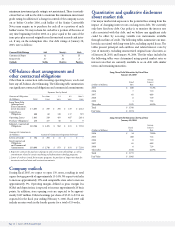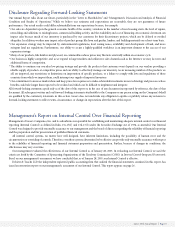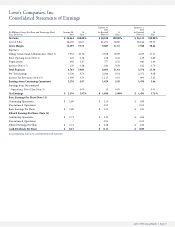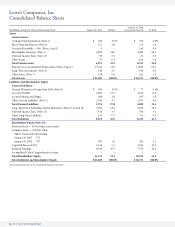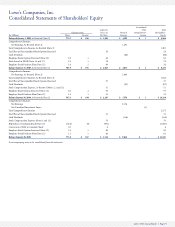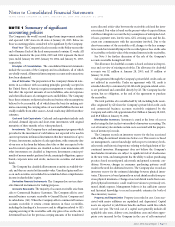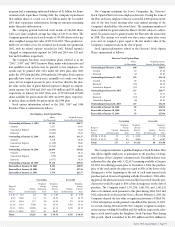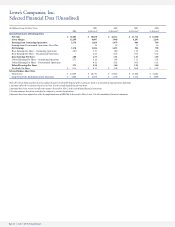Lowe's 2004 Annual Report Download - page 35
Download and view the complete annual report
Please find page 35 of the 2004 Lowe's annual report below. You can navigate through the pages in the report by either clicking on the pages listed below, or by using the keyword search tool below to find specific information within the annual report.
Lowe’s 2004 Annual Report Page 33
Certain Consideration Received from a Vendor.” See further discussion
of cooperative advertising allowances and the impact of the implemen-
tation of EITF 02-16 in Vendor Funds.
Vendor Funds The Company receives funds from vendors in the
normal course of business for a variety of reasons, including purchase-
volume-related discounts and rebates, advertising allowances, reim-
bursement for third-party in-store service related costs, defective
merchandise allowances and reimbursement for selling expenses and
display costs. Management uses projected purchase volumes to deter-
mine earnings rates, validates those projections based on actual and
historical purchase trends and applies those rates to actual purchase vol-
umes to determine the amount of funds accrued by the Company and
receivable from the vendor. Amounts accrued could be impacted if actu-
al purchase volumes differ from projected purchase volumes.
The Company historically treated purchase-volume-related dis-
counts or rebates as a reduction of inventory cost and reimbursements
of operating expenses received from vendors as a reduction of those spe-
cific expenses. The Company’s historical accounting treatment for these
vendor-provided funds was consistent with EITF 02-16 with the excep-
tion of certain cooperative advertising and third-party in-store services
for which the costs are ultimately funded by vendors. The Company pre-
viously treated the cooperative advertising allowances and third-party
in-store service funds as a reduction of the related expense.
Under EITF 02-16, cooperative advertising allowances and third-
party in-store service funds are treated as a reduction of inventory cost,
unless they represent a reimbursement of specific, incremental and
identifiable costs incurred by the customer to sell the vendor’s product.
Substantially all of the cooperative advertising and third-party in-store
service funds that the Company receives do not meet the specific, incre-
mental and identifiable criteria in EITF 02-16. Therefore, for coopera-
tive advertising and third-party in-store service fund agreements
entered into after December 31, 2002, which was the effective date of the
related provision of EITF 02-16, the Company treats funds that do not
meet the specific, incremental and identifiable criteria as a reduction in
the cost of inventory and recognizes these funds as a reduction of cost of
sales when the inventory is sold. There is no impact to the timing of
when the funds are received from vendors or the associated cash flows.
Third-party in-store service costs were included in SG&A expense
and the funds received from vendors were recorded as a reduction of
inventory cost in 2004. Third-party in-store service costs for 2003 and
2002 are presented net of vendor funds of $175 million and $69 million,
respectively.
This accounting change did not have a material impact on the 2003
financial statements since substantially all of the cooperative advertising
allowance and third-party in-store service fund agreements for 2003
were entered into prior to December 31, 2002, the effective date of the
related provision of EITF 02-16. This accounting change reduced dilut-
ed earnings per share by approximately $0.16 in fiscal 2004.
Comprehensive Income The Company reports comprehensive income
in its consolidated statement of shareholders’ equity. Comprehensive
income represents changes in shareholders’ equity from non-owner
sources. For each of the three years in the period ended January 28, 2005,
unrealized holding gains/losses on available-for-sale securities were the
only items of other comprehensive income for the Company and were
immaterial. The reclassification adjustments for gains/losses included in
net earnings for 2004, 2003 and 2002 were also immaterial.
Stock-Based Compensation Prior to 2003, the Company accounted
for its stock-based compensation plans under the recognition and meas-
urement provisions of Accounting Principles Board (APB) Opinion
No. 25, “Accounting for Stock Issued to Employees,” and related
Interpretations. Therefore, no stock-based employee compensation is
reflected in 2002 net earnings, other than for restricted stock grants, as
all options granted under those plans had an exercise price equal to the
market value of the underlying common stock on the date of grant.
Effective February 1, 2003, the Company adopted the fair value
recognition provisions of Statement of Financial Accounting Standards
(SFAS) No. 123, “Accounting for Stock-Based Compensation,” prospec-
tively for all employee awards granted or modified after January 31,
2003. Therefore, in accordance with the requirements of SFAS No. 148,
“Accounting for Stock-Based Compensation-Transition and
Disclosure,” the cost related to stock-based employee compensation
included in the determination of net earnings for years ended January
28, 2005, and January 30, 2004 is less than that which would have been
recognized if the fair-value-based method had been applied to all awards
since the original effective date of SFAS No. 123. The Company recog-
nized compensation expense in 2004 and 2003 totaling $70 and $51
million, respectively, for stock options and awards granted or modified
during the year. These options generally vest over three years.
The following table illustrates the effect on net earnings and earnings
per share if the fair-value-based method had been applied to all out-
standing and unvested awards in each period:
2003 2002
As Restated As Restated
(In Millions, Except Per Share Data) 2004 (Note 2) (Note 2)
Net Earnings as Reported $ 2,176 $ 1,844 $1,491
Add: Stock-Based Compensation
Expense Included in Net Earnings,
Net of Related Tax Effects 43 32 –
Deduct: Total Stock-Based
Compensation Expense Determined
Under the Fair-Value-Based Method for All
Awards, Net of Related Tax Effects (85) (93) (85)
Pro Forma Net Income $ 2,134 $ 1,783 $1,406
Earnings Per Share:
Basic – as Reported $ 2.80 $ 2.35 $ 1.91
Basic – Pro Forma $ 2.75 $ 2.26 $ 1.81
Diluted – as Reported $ 2.71 $ 2.28 $ 1.86
Diluted – Pro Forma $ 2.66 $ 2.20 $ 1.75
The fair value of each option grant is estimated on the date of grant
using the Black-Scholes option-pricing model with the assumptions
listed in the following table.
2004 2003 2002
Weighted Average Fair Value Per Option $ 16.56 $ 17.64 $ 19.22
Assumptions Used:
Weighted Average Expected Volatility 38.3% 44.0% 43.7%
Weighted Average Expected Dividend Yield 0.22% 0.26% 0.27%
Weighted Average Risk-Free Interest Rate 2.39% 2.89% 4.35%
Weighted Average Expected Life, in Years 3.3 5.5 4.0-7.0
Shipping and Handling Costs The Company includes shipping and
handling costs relating to the shipment of products to customers by third
parties in cost of sales. Shipping and handling costs, which include salaries
and vehicle operations expenses relating to the delivery of products to cus-
tomers by the Company, are classified as SG&A expenses. Shipping and



